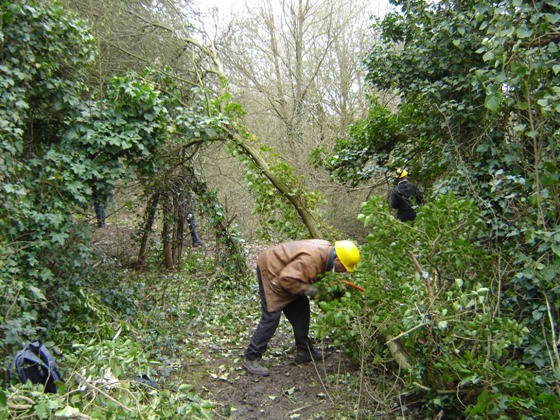CROW (Conserve Reading on Wednesdays)
Wednesday, 7th April 2010
The Cowsey, Whitley ~ Path clearance

Much of our recent work at this site has been aimed at improving access, however the snow of last December and January had brought down a number of ivy covered trees and flatten bushes, leaving paths blocked.

Opening up the paths will not only make them usable for walkers but allowing in more light should help increase the diversity of ground cover plants.

CROW's team: Terry, Ricki, Phil, Mike, Judith, John, Keith and Alan. Our thanks to Keith for the photo's. During the day John took time out to survey the site's bird population the results from which follow.
Bird population survey
A 30 minute walk through the centre of The Cowsey and return near the top edge recorded sixteen species. All were common residents except Blackcap and Chiffchaff which, although a few over-winter, are likely to be returned summer migrants. A later survey will discover other summer migrants but April is a suitable time to find resident species that have either begun to breed or are establishing territory. Hence many birds are heard rather than seen that at other times of the year would escape detection.
Only a small proportion of the birds are discovered during such a survey as (a) not every part of The Cowsey was visited (b) the great majority of the singing birds are males and an equivalent number of females will not be discovered. However, a rough total population can be estimated from such results.
| Results | ||||
| Species | Count | Listing | Estimated Population (very rough) |
Breeding Evidence |
| Blackbird | 5 | 28 | Singing male | |
| Song Thrush | 3 | Red | 6 | Singing male |
| Robin | 23 | 50 | Singing male | |
| Dunnock | 2 | Amber | 10 | Singing male |
| Wren | 3 | 12 | Singing male | |
| Greenfinch | 2 | 8 | Observed in suitable habitat | |
| Great Tit | 9 | 30 | Singing male | |
| Blue Tit | 2 | 16 | Observed in suitable habitat | |
| Chiffchaff | 8 | 20 | Singing male | |
| Blackcap | 2 | 6 | Singing male | |
| Woodpigeon | 43 | 50 | Observed in suitable habitat | |
| Magpie | 8 | 10 | Observed in suitable habitat | |
| Jay | 2 | 6 | Observed in suitable habitat | |
| Jackdaw | 4 | 10 | ||
| Carrion Crow | 1 | 4 | ||
| Great Spotted Woodpecker | 1 | 4 | Observed in suitable habitat | |
Species found after the survey included: Long-tailed Tit (Observed in suitable breeding habitat), Green Woodpecker (Observed in suitable breeding habitat) and Red Kite. A Grey Squirrel was also seen.
Bullfinches (red listed) have been heard on every previous visit and so are likely to be present as the habitat is particularly suitable.
Population estimate is very approximate and concludes birds likely to be breeding or regularly using the site. A small number of species will have been missed and later summer migrants are yet to arrive.
Red and amber listing refers to RSPB classification of high and medium conservation concern. The main criteria in this case are a decline of 50% or 25% in the last 25 years.
Conclusion. Numbers found indicate a dense population and a particularly good breeding area. The mix of habitat is an important factor the main ones being dense scrub, for cover and nest sites, open patches and grassland, for feeding opportunities, and mature woodland. Nearby gardens present further opportunities as do two adjacent large mown fields.